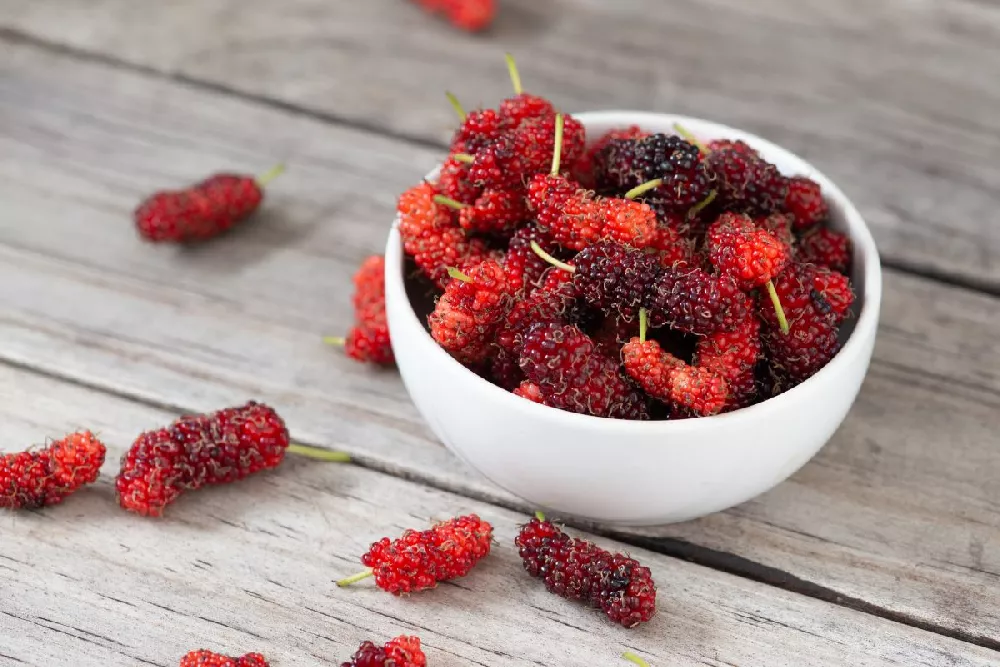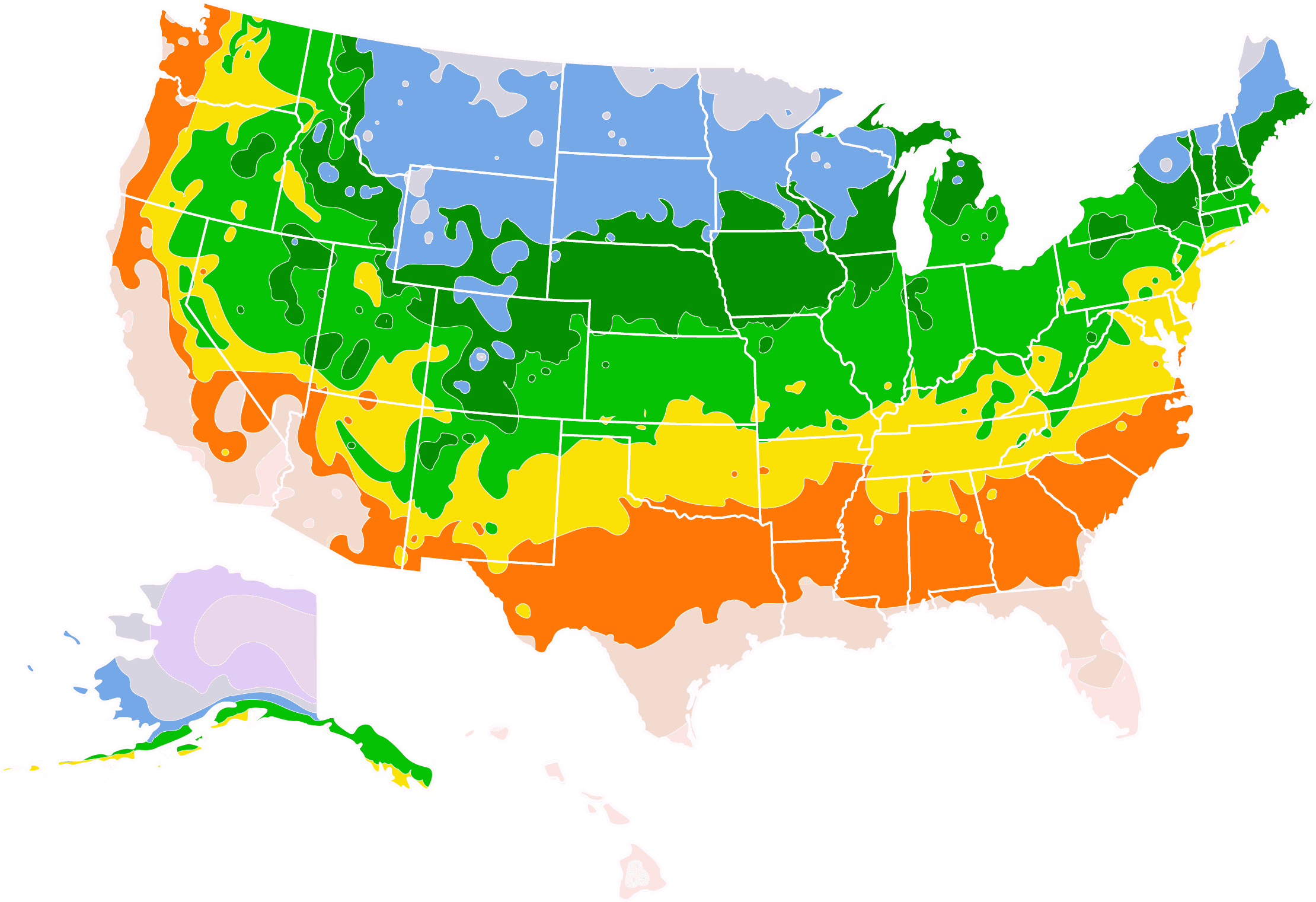- Home >
- Shrubs and Bushes >
- Berry Bushes >
- Illinois Everbearing Mulberry
Illinois Everbearing Mulberry for Sale - Buying & Growing Guide
Mulberries don't often get the respect they deserve, but the Illinois Everbearing Mulberry, Morus 'Illinois Everbearing,' could change that. This tall, handsome tree makes a great specimen planting in a yard, standing a stately 30 to 35 feet tall. But it's the fruit that is worth focusing on. Mulberries are not as common as many other fruits and are rarely seen in the grocery store. But that doesn't mean they're not tasty — the Illinois Everbearing mulberries are sweet and juicy and can be used in any recipe that calls for berries. They can even be eaten fresh from the tree and are great when dried and used in a trail mix. The trees are easy to care for, too, and need little extra help to thrive. Here are a few more reasons to plant one or more in your garden:
- They grow well throughout most of the U.S.
- In spring, the trees are covered in small yellow trumpet-shaped blooms.
- Pest and disease-resistant.
Enter your zip code to find nearby stores that may carry this plant.
Plant Care
Sunlight

The Illinois Everbearing Mulberry thrives in partial to full sun — at least four hours of direct sunlight a day.
Watering
Water trees weekly, unless it is very hot or dry, in which case increase your watering schedule.
Fertilizing

Fertilize in spring with a balanced, slow-release product designed for fruit trees and shrubs.
Planting and Care
Planting instructions
Choose a site for your Illinois Mulberry that receives at least four hours of direct sunlight a day. Unpot the sapling and tease out any encircling roots, which can girdle the tree and slowly kill it. Dig a hole that’s as deep as the root ball and twice as wide. Place the tree in the hole, spreading out the roots. Holding it upright and steady, fill in around the roots with topsoil mixed with well-rotted compost or manure, tamping down as you go to eliminate air pockets. Water thoroughly. Apply a two to three-inch layer of organic mulch such as bark chips around the root zone to conserve moisture and hinder weed growth but keep it from touching the trunk to avoid problems with rot.
Watering and nutrients
Water newly-planted mulberry trees every few days until you see signs of robust new growth on the branches. Mature mulberries will appreciate at least an inch of water each week. During very hot or dry weather, you may need to increase supplemental watering. Fertilize in early spring with a balanced product designed for fruit trees and shrubs. Regular application of a layer of compost under the mulch can also help your tree to thrive.
Pollination
Mulberries are generally wind–pollinated, although they do attract pollinating insects such as bees and butterflies. They are self-fertile, and a single tree has both male and female reproductive organs. That means you’ll be able to harvest the fruit with only one tree. You will, however, have a larger and higher-quality harvest if you plant two or more trees near each other.
Pruning
Your mulberry does not need the extensive pruning that some fruit trees need. Prune out any dead, diseased or damaged branches whenever you see them. In late winter, you can do light pruning to remove limbs that rub against each other or to open up the canopy to light and air.
Pests, diseases, and animals
The Illinois Everbearing Mulberry is generally resistant to pests and diseases. Insects that you may see on it include the spotted wing drosophila and the brown marmorated stink bug. A healthy tree will not be harmed by either of these. Diseases that will rarely be seen include cercospora leaf spot and fusarium canker. Leaf spot will cause small brown spots on the leaves, which should be pruned out. Keep the area around the tree free of leaf debris and litter, and always water at the base of the tree, not on the leaves. Deer have been known to browse smaller trees, while birds flock to the ripe fruit.
Harvesting
Mulberries are ripe anytime between mid-June and August, depending on where the tree is located. Ripe fruits are soft and a deep red that can be nearly black at times. They are fragile and can be picked by hand. If the tree is large enough, it may be easier to spread a tarp underneath it and gently shake the branches to collect fruit.
Achieving maximum results
Many gardeners grow mulberry trees for the sweet and tasty fruit, but it’s worth noting that this is a handsome tree with a pleasing silhouette and glossy dark green leaves, and you can achieve maximum results by using it wisely in your garden or landscape. It’s not a small tree, with a mature height and width of roughly 30 to 35 feet; so, it may not be the right choice in a smaller garden — although its size can be somewhat controlled through judicious pruning. In a larger garden, however, it can serve as an excellent specimen planting, either alone or with one or two others. Consider a grouped trio underplanted with shade-loving perennial groundcovers such as lilyturf. Because of the tree’s size, it’s best not to locate it under overhead utility wires or cabling, and if used in a foundation planting, it must be spaced at least 15 feet away from your home. It’s also best to place it away from sidewalks or driveways, as the fallen fruit can be problematic underfoot.
FAQs
Where can I grow an Illinois Everbearing Mulberry?
This sturdy tree is hardy down to -20 degrees Fahrenheit, which translates into USDA hardiness zones four through eight. That includes most of the continental U.S., with the exception of the semi-tropical areas of California, Texas and Florida, and most northern parts of the Midwest and New England.
How are mulberries used in cooking?
Mulberries have a flavor that includes both tart and sweet elements — some think it tastes like grapes, and others say it's more similar to a blueberry. Either way, it can be eaten directly off the tree but is more commonly used in cooking. Mulberries make excellent jams and jellies. They are good in pies, and mulberry muffins are very tasty. In general, any recipe that calls for berries — from ice cream to mojitos — will be fine with mulberries.
Are mulberries messy trees?
Not overly so. Like any deciduous tree, mulberries shed their leaves in the fall, and these should be raked up and mulched. If the mulberry's fruit is not picked, it will eventually fall to the ground. This is why it's best to place a mulberry away from any sidewalks, as it can be messy underfoot during the summer.
Compare Similar Products
You can't add more Product Name - Product size to the cart.
OK









